By Sandra Guidi, Lauren Chang, Lora Kinkade, Marlie de Swart, and Lynn Moody
The following pieces are written by five Fibershed producer members offering their perspectives on the creation of a community-constructed sweater using Santa Cruz Island sheep wool.
The Shepherdess – Sandra Guidi, Black Rock Ranch

We searched for years to find a breed of sheep that would prove the perfect partner on Mount Tamalpais, where we live on the western foot. It’s where we moved after long careers in the service industries and raising our family on the other side of the mountain. There is a long story of how we arrived on the mountain, but the short one is that something guided us here, and from the moment we stepped foot on the mountain, we have held a deep reverence and gratitude, seeking to understand and support the origin and history of the mountain along with evolving environmental concerns, social justice issues and a changing world. For thousands of years, the Coast Miwok stewarded the land and waterways. In the 1800s, White Gate Ranch and the Silva family leased three separate parcels from the area’s largest land owner, William Kent, totaling approximately one thousand acres with cattle, dairy cows and pigs until the land was acquired by the Golden Gate National Recreation Area (GGNRA) in 1974. Much of the history seems lost on the millions of visitors arriving each year to visit the beach or hike the mountain.
The passive solar home we currently live in was constructed in the late 1970s over a period of almost two decades; in between building the house with the assistance of a local contractor, the creators worked as defense attorneys, using reclaimed materials and the foresight of a predominantly south face to capture the sun — an effective heat capture in a temperate climate. While at one point the couple had llamas and some sheep, the landscape looked very different than it does today.
Early on it became abundantly clear to us that managing the land by mechanical means was inefficient on the appreciable mountain slope; each year we witnessed the abundant growth, struggling to manage and understand how to work in concert with nature, and each year we celebrated another trip around the sun (hopefully) pocketing a small amount of wisdom along the way. We began considering sheep not long after moving to the mountain and settled on the Santa Cruz Island breed in 2015 — the same year we attended a grazing class through Fibershed and met Rebecca Burgess, whom we have long called our north star.
The idea of Santa Cruz Island sheep was suggested by Fibershed member Marie Hoff, and we were able to locate a breeder of these critically endangered and talented sheep not far from us at Blue Oak Canyon Ranch. Lynn Moody is a wealth of information and wrote a deep historical piece on the sheep, which can be found on the Livestock Conservancy website.
Before the sheep arrived on the mountain, an acrobatic farmer friend with a masticator mulched the impassable coastal scrub while we watched with wide eyes. Since then our perfect mountain partners have done a masterful job in providing the dual efficiency of both browsers and grazers, true to their feral roots. Their genetic adaptations of small stature ensure less erosion on the mountain, drought tolerance for California’s changing landscape and an ability to thrive on poor forage for our mountain landscape and a warming earth.
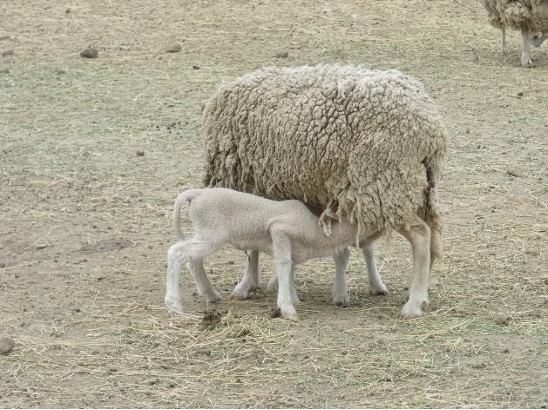
We recently sent the sheep further up the mountain after partnering with GGNRA to provide vegetation management and fuel reduction assistance. We are grateful to Fibershed, as a recipient of the Carbon Fund Seed Grant, which has allowed us to provide this service to the mountain. Most days we walk the sheep through our back gate and farther up the mountain accessing the steep and challenging landscape with a predominance of Helichrysum, an overly vigorous escaped landscape plant that is both a climber and a spreader, and thick Douglas fir forest.
There is great clarity and value in the work our sheep perform, and we have taken thousands of photos to compare and contrast their breadth of work. As shepherds, we are keenly aware of where our sheep have traveled, the forage they have consumed and turned into fertility, returned directly to the soil and grown protein in the form of wool on their small bodies. This has allowed us a deep appreciation for the aspects of wool in general and a relationship of deep respect with the landscape where the sheep browse and graze. Our sheep grow a variable and uniquely crimpy wool, and we guarantee you will find at least some evidence in it of the pastures and places our sheep have been. For us, the bits are part of the allure, the challenge inspiring.
The Breeder – Lynn Moody, Blue Oak Canyon Ranch
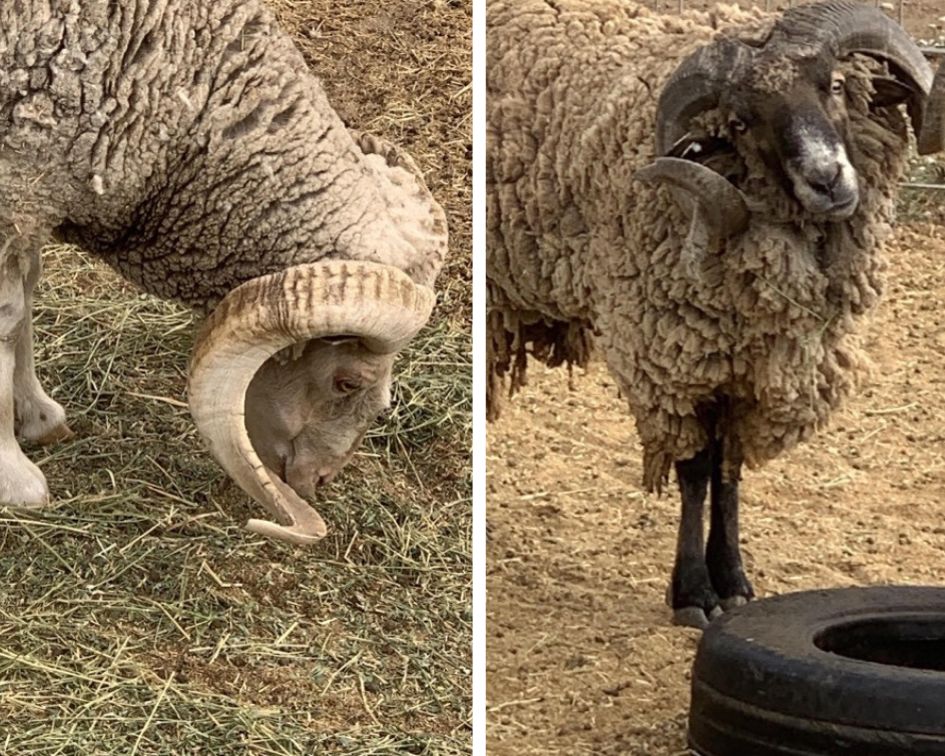
As a fiberista, the temptation has been to breed for fiber quality — a longer staple length in addition to crimp, fineness, and softness. Yet there are other specific traits of the Santa Cruz Island sheep — an extremely rare breed originating in Santa Cruz Island off the coast of California — that are essential to preserve, including small-ish size, hardiness, ability to thrive on poor rangeland, hoof health, horn configuration (of rams), good mothering qualities, and intelligence.
The Livestock Conservancy defines three “lines” of the Santa Cruz Island sheep breed: Stanley, Paroski, and Hopkins. Of the three, the generally white Paroski sheep have better wool for spinning. Stanley sheep tend to be smaller, shedders with short staple wool, (nevertheless nice to spin) and have hard hooves, which helped them out on the rocky and mountainous Santa Cruz Island. Our Stanley sheep are all white except for Margarita who is spotted on her legs and face, but still has white wool. Paroski sheep are often smaller and stockier with shorter legs, while Hopkins sheep tend to be taller with proportionately long legs. Hopkins and Paroski sheep include various beautiful shades of brown, and the brown wool can shed and be neppy.
Emmy and Smudge (the sheep which the wool sweater in this story is made from) are twins — their dam is MS 214, one of our original Stanley flock, and their sire is Twelve, who is also a Stanley sheep (his dam is 292 and his sire is Butch Cassidy, both part of our original flock from Marion Stanley). For Stanley sheep, both MS 214 and Twelve are pretty good woolers. At the time when Sandra and Rob Guidi were sheep shopping, all our breeding ewes and all but two rams were Stanley sheep. Three of the original four Guidi sheep were “pure” Stanley; May is half Stanley and half Hopkins. Since, they have acquired two Paroski ewes and a half Stanley/half Paroski wether. We experiment with management techniques to improve wool quality given the genetic baselines, but we use the sheep to browse and graze down wildfire fuel, so we always have vegetable matter (VM) in our wool — that’s a promise!
The Shearer – Lora Kinkade
The Guidis of Black Rock Ranch are one of the only clients I will (happily) spend most of a day during busy shearing season with. Most sheep are flighty by nature, and I’ve heard the Santa Cruz Island sheep described as particularly skittish, but, unlike many overly developed breeds, their wariness seems intelligent, proportionate. Their fiber is definitely precious to work with—one second cut (a common fault in the shearing step of fiber processing where the fiber is shorn off mid-staple and not flush with the skin) diminishes the staple length by half, where there was not much to begin with.

Santa Cruz Island sheep are a lot smaller than most of the sheep I shear. I’ve heard an old-time shearer say, anecdotally, that most breeds of sheep have doubled in size since they started shearing four or five decades ago. Meanwhile, the shearing pattern and handling of the sheep while it is being shorn has not changed despite this notable change in the animal’s size and weight. I commonly shear over 100 animals a day weighing close to my bodyweight or more. Breeds like the Santa Cruz Island sheep are a physical relief for shearers—and for the ranchers too. Historically, sheep have been “human-sized”—you could easily handle or pick them up to doctor or otherwise tend to them. As the commercial and meat industries continue to favor larger, bigger boned animals (think Suffolk, Dorset, Hamp), the wool industries too favor bigger sheep and bigger fleece. Sheep are increasingly becoming more difficult for both rancher and shearer to safely manage without excessive corrals, dogs, and elaborate stockmanship. The Santa Cruz Island Sheep are a welcome exception to this trend!
The Fiber Processor – Lynn Moody
In 2013, we acquired an antique Greenfield “sample card,” which is a small version of a large card (carding machine) that commercial/ cottage carding businesses have for processing wool. It’s called a sample card because it was used to make samples of fiber blends for customer approval (or not) before committing to a large lot. (An aside: the machine is a card and the person running it is the carder.) After some experimentation with carding Santa Cruz Island (SCI) wool, NavajoChurro wool, and llama fiber, we set up the card to do only SCI wool — short staple, crimpy, fine, delicate — although I have been known to sneak in a little cotton or Angora rabbit fiber along with the wool, once in a while.
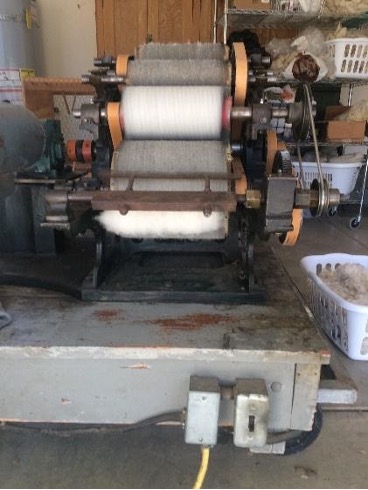
The wool for Sandra’s sweater (the sweater for which these stories are building upon) is pure SCI. Our sample card removes the chaff from the washed, picked wool, and about 60% of the larger VM such as grass seeds.
After shearing, the steps for processing the wool begin of course with skirting, then washing the fleece. Washing is my bottleneck, and is quite difficult for greasy fine fleeces of any breed — our water is groundwater, and very hard (high in calcium and magnesium). I required Sandra to wash her fleeces before sending them here for processing, and I don’t think it was easy for her to do either. After washing and drying a fleece, I run it at least twice through our human-powered bench picker, also adjusted to be as gentle as possible so as not to rip apart the fibers. Then the picked wool is fed gradually to the card via its conveyor — it is picked up by the various cylinders, and goes through the system. We have four stripper/worker sets after the licker-in, and those work with the swift (the big cylinder in the center, that you can’t see in the photos). The fancy interacts with the swift to raise the fibers off the swift, the doffer picks up the fibers, and if all goes well the carded fiber comes off the doffer as a very thin, delicate sheet (about 10 inches wide). We don’t have a roving maker so the sheet of carded SCI wool rolls itself up in a kind of jelly roll of wool that I call a machine-carded rolag. I sent the rolags back to Sandra, who sent them to Lauren, The Spinner, and there begins the next chapter…
The Spinner – Lauren Chang
I first learned about Santa Cruz Island (SCI) sheep from Marie Minnich. We were standing in the parking lot of the 2016 Maryland Sheep and Wool Festival admiring fleeces from her flock. I was starting to spin more from raw fleeces and loved Marie’s fleeces and her commitment to conservation breeding of Romeldale CVM sheep. At some point she mentioned that if I really wanted to try something special that I should try to get my hands on an SCI fleece. I always listen to what fiber producers share with me; they have never failed to enrich my understanding of fibers. When I returned to Chicago, I researched the breed and acquired a small brown SCI fleece. Its fiber was short, fine, crimpy, and displaying a full range of vegetal matter. Processing and spinning were challenges, but the fiber and the history of the breed are unique. I was hooked.
In early 2020 I was seeking ways to apply my hand skills and textile knowledge outside of my studio. Around the same time Sandra and I renewed our conversations about SCI and the process of fleeces becoming yarn. Sandra sent me some of the rolags Lynn made and a bit of roving to try out.
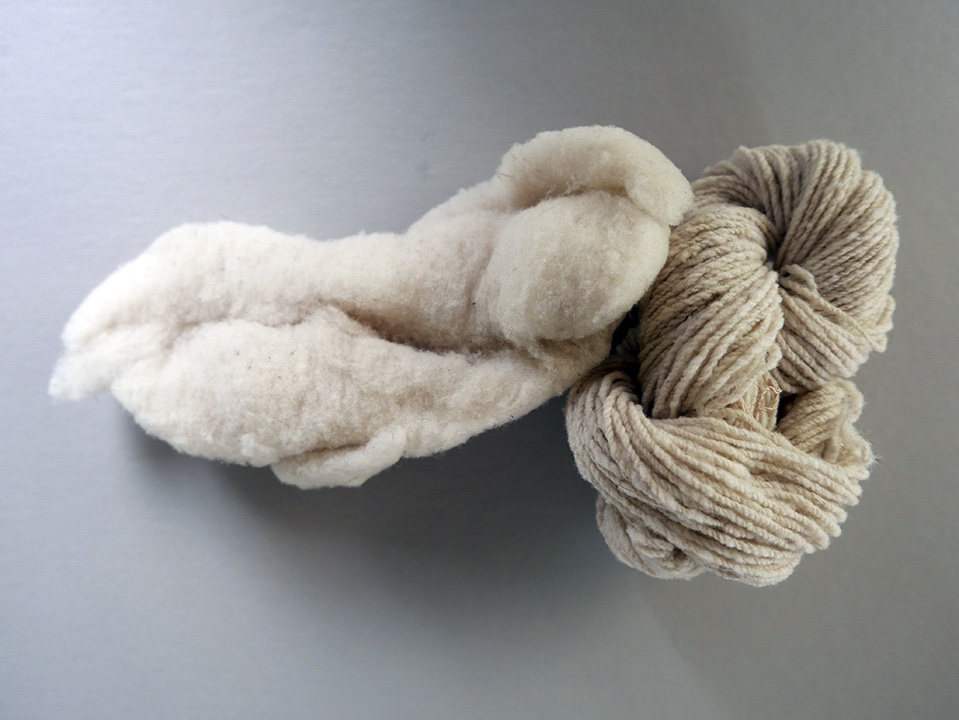
The more Sandra and I spoke, the more I began to understand her hopes for her fleeces. I have always been fortunate to work with fiber producers who care deeply for their flock, and Sandra is no exception. From our talks, it seemed of utmost importance to provide responsible stewardship for her flock, which includes processing their fiber. She also deeply loves her sheep, and I felt she wanted to share this love with as many people as possible. While it is not feasible for many of us to have sheep, we can support fiber producers by supporting their stewardship. I believe in the transformative power of experience, and yarn could be the ambassador for Sandra and her flock.
With that brief in mind, I set to work. I aimed to spin a consistent yarn that balanced yardage while also maintaining the unique characteristics of Sandra’s flock. Handwork is as humbling as it is rewarding, and SCI is no exception. My role as a hand spinner is to coax out a yarn from each fleece that celebrates its beauty and unique qualities. It took months to understand SCI’s range and characteristics. While SCI is considered to have a short staple, I found that the staple is not so much short as incredibly springy, and so I adjusted my movements to suit the fiber. I have been spinning each fleece individually, so the particular characteristics of genetics, that year, and each animal are more pronounced in these yarns than they might be in a roving that blends the entire flock. Working in this manner, I can better attribute peculiarities to fiber, sheep, prep, spinner and provide Sandra with records for her flock. In the beginning I spun a lot of bad yarn, and there is no point at which I spin SCI on autopilot. But I love the experience of making micro-adjustments with my head and hands, and slowly, I am starting to understand, and hence love, each of Sandra’s sheep.
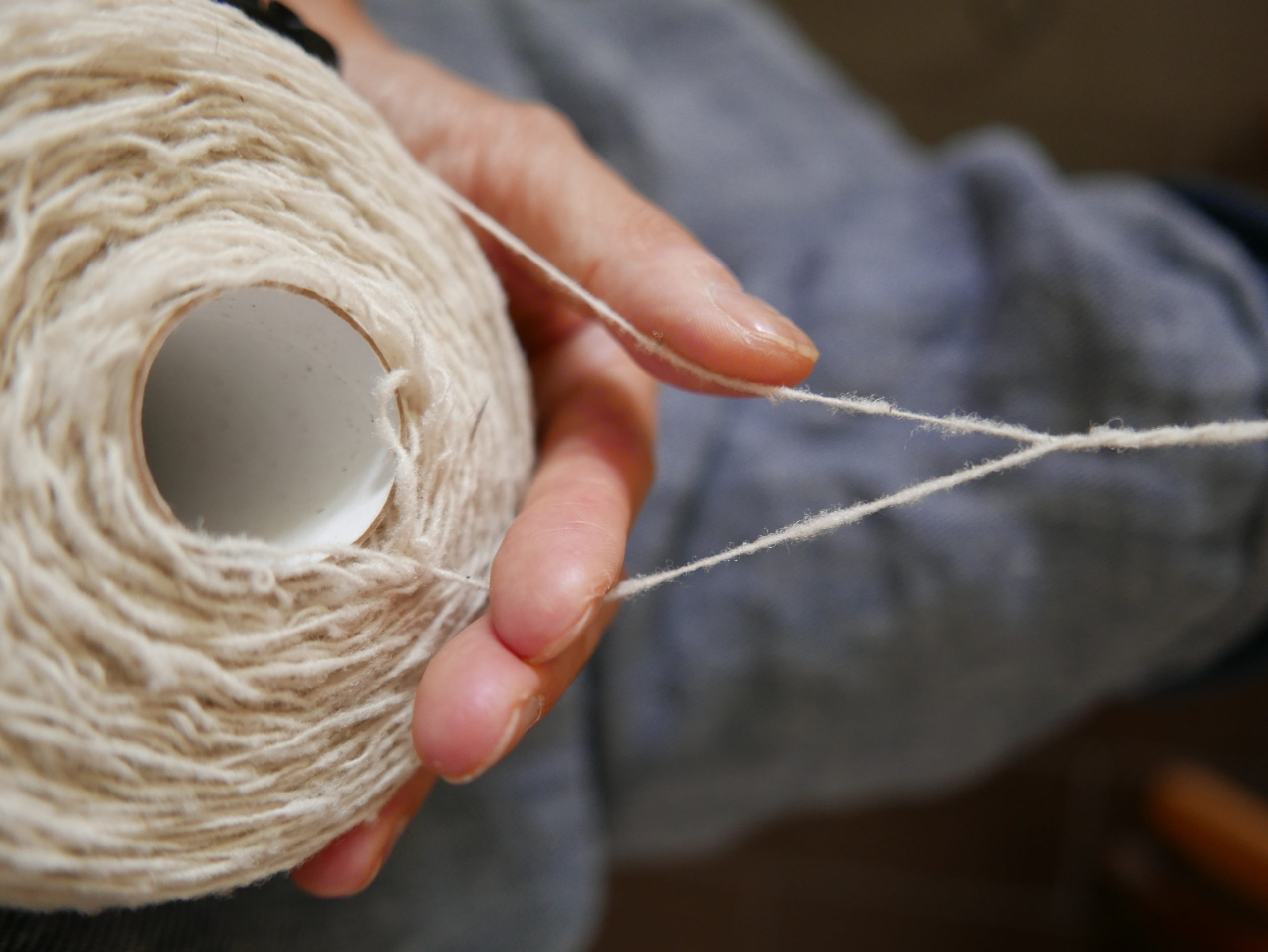
Sandra’s delight in seeing the yarn from her flock is why I spin, and spin fiber almost exclusively from small farms. Taking ideas and fiber that have potential and turning them into something tangible is part of the joy of handwork. Sandra and I have only met through the ether — email, DMs, FaceTime. A connection through yarn has developed into a friendship, and I understand so much more about land and animal stewardship through working with Sandra and Lynn. These rolags are a testament to the power of wool and community to work deep, long-lasting change.
As the yarn started to accumulate, Sandra was tentative to use the yarn. In the past when I have felt a yarn was too precious to use, a good friend of mine would walk me to her window, show me her sheep, and say, “Lauren, they’re growing more outside.”
As a spinner who also makes textiles, I also encouraged Sandra that we only understand fiber and the yarn once we make it into something we can use or wear. Incorporating fiber into our lives is part of the circle of stewardship. It deepens our understanding of and appreciation for the land, sheep, and community. I am so very glad she made this sweater and so honored to be amongst this group of incredible women. Thank you…and on to the sweater.
The Designer & Knitter – Marlie de Swart
It all began with tea. Special tea. Home-made tea from flowers and herbs right there next to the patio, with a splendid view over the ocean. A gentle question/request and of course I would attempt to knit a sweater, or a cardigan. I knew of the many years of Sandra’s attempts to get the Santa Cruz Island wool milled and spun, and I admired the dedication she had put into making this “different” wool useful.
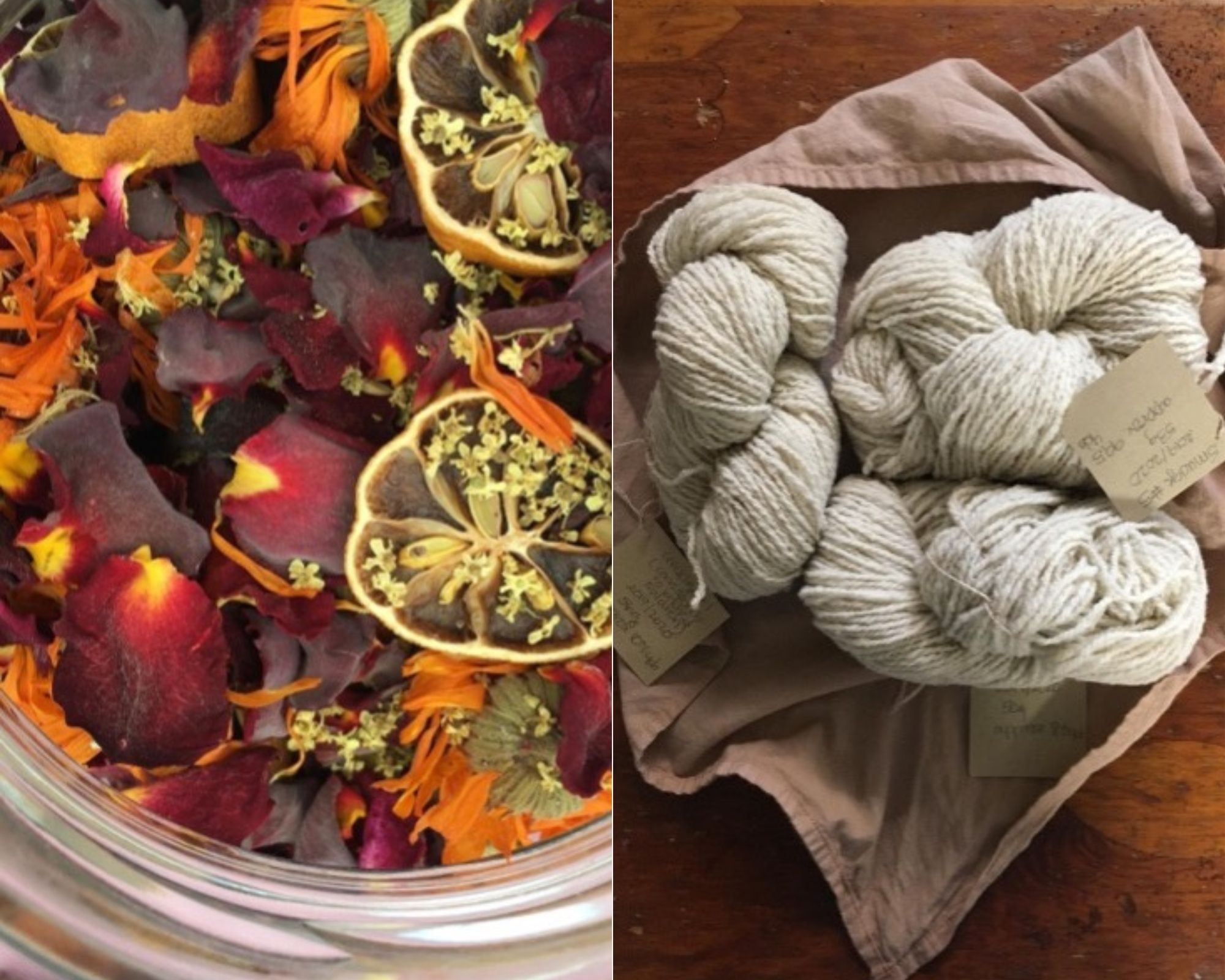
The wool of the Santa Cruz Island sheep is very short stapled, therefore, very difficult to spin. I tried it and was not very successful. The skeins Sandra brought to my attention were masterfully spun: 2 ply, worsted weight, naturally creamy white. Only 3 skeins though, not enough for a sweater. I took all the other bits of wool Sandra had and began to knit top down, so I could make it short if I ran out. The first batch of handspun wool was from the sheep Emmy (mentioned and seen in Lynn Moody’s piece “The Breeder”).
I asked for an easy-fitting sweater I could use to get the right size and measure my progress. Fitting sessions to assess my progress was also an excuse to get together with Sandra and hear her stories of the sheep and land in the Stinson Highlands just on the other side of the lagoon from me.
When I came to the point where I separate the front and back from the sleeves, I panicked a bit. I had very little yarn left, (one skein out of the 3), so I used some naturally dyed yarn to create a band along the sleeves and bodice. It only added one inch. So back to white for the sleeves. I divided what I had left, which was enough to make the sleeves an even length.
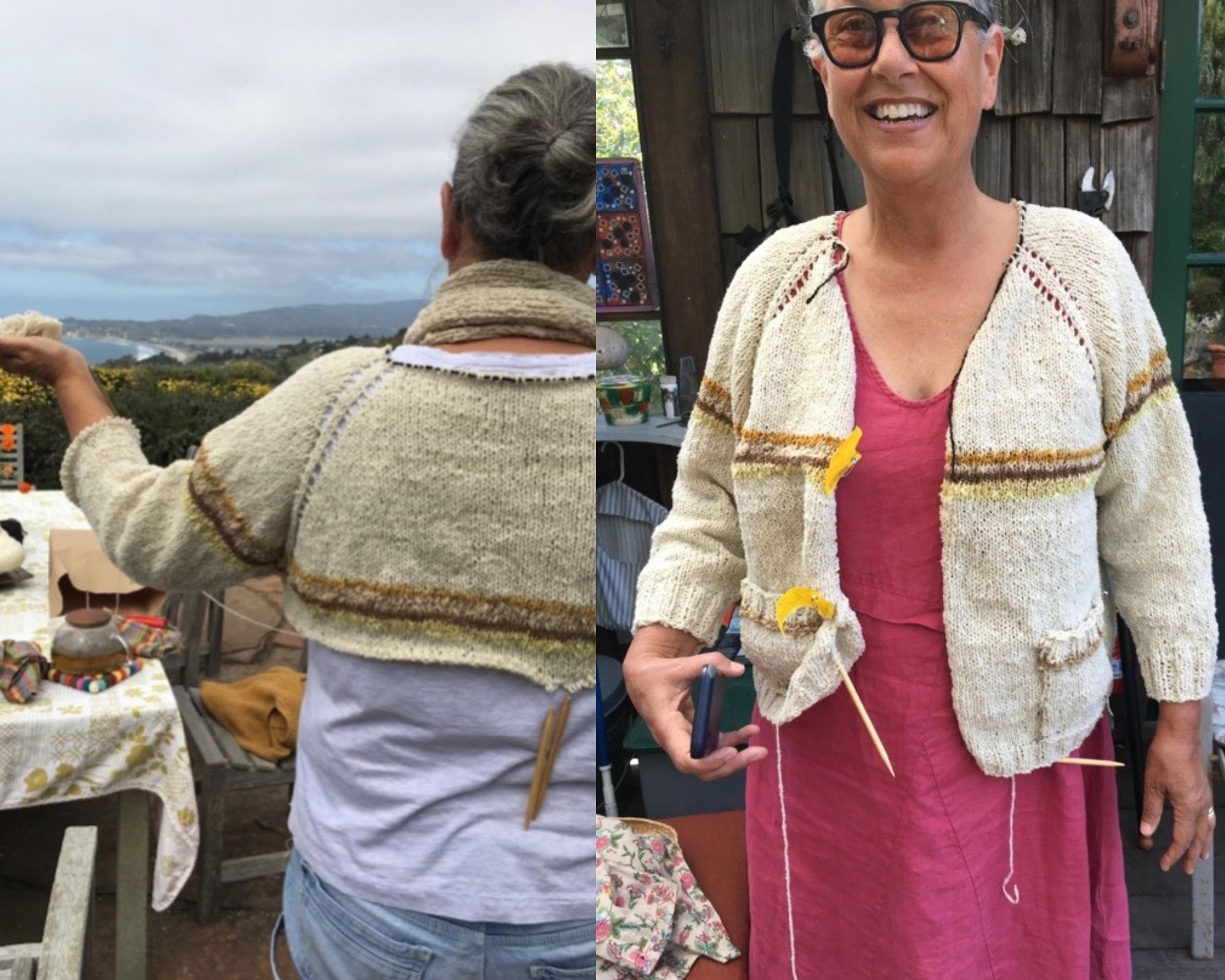
And then another bundle arrived with more handspun skeins! These were skeins made from Smudge’s wool, the twin sister of Emmy, the original sheep. They were the same color and enough to finish the cardigan. I could add enough length to the sleeves to where Sandra wanted the sleeves to end and make the body long enough and do the finishing touches.
And of course it had to have pockets in the right place. The beautiful olive tree buttons, made by her husband, were the finishing touch.
Working with the Santa Cruz wool was a special experience. It is unlike any other wool because it is soft to the touch yet it has a very rustic feeling. Almost like you can feel the forest and plants and shrubs on the hillside the sheep feed on. A perfect working sweater.
The Owner of the Sweater – Sandra Guidi
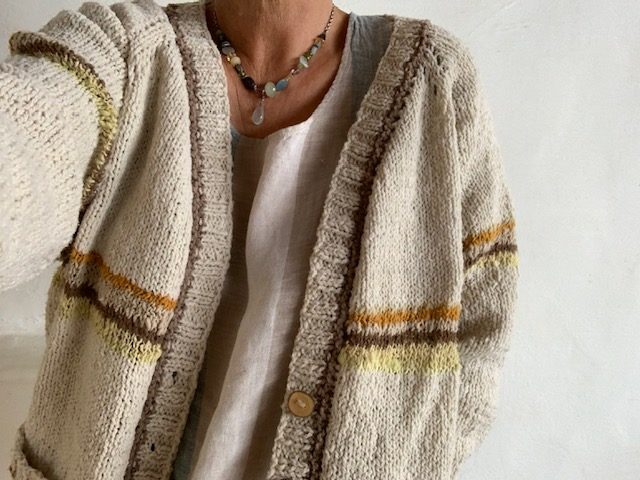
With all of the discussion and background centered on place, you may be wondering about our wool… I did not arrive here with any experience of sheep, raw wool or as a spinner, knitter, crocheter or artisan and the idea of wool was more an afterthought given the value our sheep provide in managing the mountain. I confess the short staple and elasticity have proven challenging as a beginning spinner; the journey of finding a mill is longer and still unfolding.
In truth, I have struggled to find a way to process the wool in a manner befitting these soulful and noble sheep, and am profoundly grateful to the Fibershed friends who have reached out with helping hands to offer assistance and bring this special wool to life in the form of a charming and rugged Working Sweater. The project has allowed for a slow and thoughtful journey, a deep understanding of values and a depth of gratitude I’ve had difficulty putting words to.
The Working Sweater was created with handspun yarn from our twins, Emmy and Smudge. Their sire is Twelve, who’s sire Butch Cassidy.
I am humbled by the kindness shown to me by the contributors of the Working Sweater on the wool journey I have traveled. With deep appreciation for my Fibershed and to Lynn Moody (the Breeder and the Processor, @Blueoakcanyonranch), Lora Kinkade (the Shearer, @loralouk), Lauren Chang (the Spinner, @interstitialspaces) and Marlie deSwart (the Designer and Knitter, @marliedeswart), whose hands and hearts contributed to this sweater and all of whom have written their own stories here.
